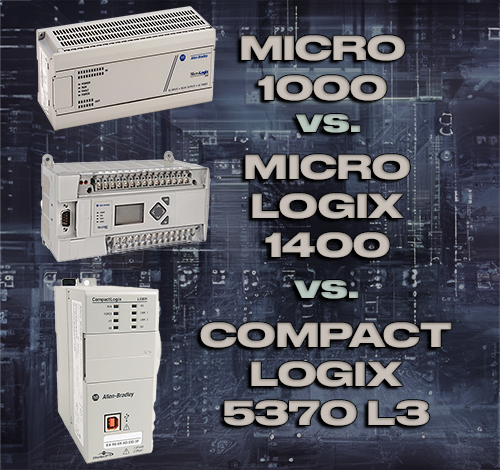Allen Bradley's Micro 1000, MicroLogix 1400, & CompactLogix 5370 L3
Ultimately, the choice between upgrade options will depend on the specific needs and goals of your facility. If your primary concern is increasing production while minimizing costs, the Micro 1400 would be a no-brainer. However, if you’re looking for a more scalable design and faster processing speeds with advanced features, the CompactLogix 5370 L3 might be worth the investment.

First, we must take a look at the positives of each of these components.
Micro 1000:
1. Compact and cost-effective PLC designed for small-scale applications.
2. Supports ladder logic programming.
3. Limited number of I/O points, typically suited for simple automation tasks.
4. Compact form factor with integrated I/O and communication options.
MicroLogix 1400:
1. Compact and cost-effective for easy and affordable installation.
2. Supports ladder logic, structured text, and function block diagrams programming with a simple interface that makes it easy to program and operate.
3. Higher capacity compared to the Micro 1000 in terms of I/O points, memory, and program complexity.
4. Built-in communication ports, including Ethernet options
5. Common features include 20 digital inputs, 12 digital outputs, expandability with I/O modules, online editing capabilities, and memory for program and data storage
CompactLogix 5370 L3:
1. Scalable and Flexible. This is a versatile PLC that can be used in a wide range of applications and allows the user to customize and configure the system to meet specific needs, that can be easily expanded for those that are looking to expand operations over time.
2. Supports ladder logic, structured text, and function block diagrams programming with a easy to use and maintain interface.
3. Advanced features such as motion control, safety control, and networking capabilities that can aid in operations.
4. Multiple communication options, including Ethernet/IP.
5. Offers a range of I/O modules and expansion capabilities for flexibility in system design.
6. Enhanced processing power, memory, and program capacity compared to the MicroLogix series.
Now that the benefits are established, it is important that we cover the negatives in order to make an educated and proper decision for your business.
Micro 1000:
1. Extremely limited capabilities. It has limited memory and processing power which is is not sufficient for complex automation tasks. (If your use case requires a high-performance PLC, you may want to consider other options)
2. Limited expansion. This device will most likely not be able to accommodate future growth or changes in automation needs as when the need arises for additional I/O’s or advanced functions a more scalable solution will be required.
3. Limited Connectivity. In situations which require multiple device/system integration, you may find that this PLC is not for you and you will need one that can communicate with a wide range of devices and protocols.
4. Compatibility Issues. Anything that is purchased, must be able to be used with the legacy software and units.
MicroLogix 1400:
1. Compatibility Issues. Anything that is purchased, must be able to be used with the legacy software and units.
2. Eliminates up-front cost not having to fully upgrade the entirety of your system, however this limits your functionality and expandability, and simply delays the fact that units will have to be upgraded.
3. Limited Expandability. You are confined to the same number of I/O’s as the Micro1000, thus limiting the amount of units that you can automate, and the complexity of the program.
CompactLogix 5370 L3:
1. The up-front cost is very high, as this most likely will require a system upgrade in it’s entirety. Though, this eliminates the need to keep out of date and end of life spare parts on hand.
2. Size, as is slightly larger than the 1400 and 1000 and may require more space.
The selection of the appropriate upgrade option for your facility largely depends on your specific needs and goals. If you prioritize cost-effectiveness while enhancing your production output, then the Micro 1400 would be the ideal choice. On the other hand, if you aim to improve processing speeds and advanced features in a more scalable design, the CompactLogix 5370 L3 would be a worthwhile investment.
Share this post: on Twitter on Facebook
